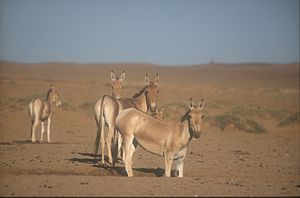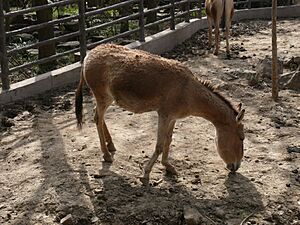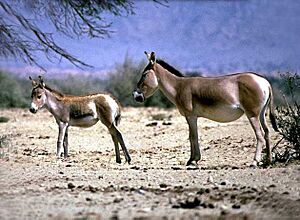Mongolian wild ass facts for kids
Quick facts for kids Mongolian wild ass |
|
|---|---|
 |
|
| Mongolian wild asses in the Gobi Desert, Mongolia. | |
| Conservation status | |
| Scientific classification |
|
| Kingdom: | Animalia |
| Phylum: | Chordata |
| Class: | Mammalia |
| Order: | Perissodactyla |
| Family: | Equidae |
| Genus: | Equus |
| Species: | |
| Subspecies: |
E. h. hemionus
|
| Trinomial name | |
| Equus hemionus hemionus Pallas, 1775
|
|
| Synonyms | |
|
|
The Mongolian wild ass (Equus hemionus hemionus), also called the Mongolian khulan, is the main type of onager. You can find it in southern Mongolia and northern China. It used to live in eastern Kazakhstan and southern Siberia. But it disappeared from those areas because of too much hunting.
As of 2015, the Mongolian wild ass is listed as Near Threatened by the IUCN. This means it's close to becoming endangered. About 42,000 of these animals live in Mongolia. Around 5,000 more live in Northern China. The name khulan is similar to the word for a wild ass in Turkmenistan.
Contents
Where Do Mongolian Wild Asses Live?
The Mongolian wild ass mostly lives in the Gobi Desert. This area has dry grasslands, semi-deserts, and deserts.
Even though it's the most common type of wild ass, it has lost a lot of its home. In the last 70 years, it lost about half of its living space in Mongolia. A long time ago, it lived across most of Mongolia. It also lived in parts of Siberia, Manchuria, and western China. But its living area got much smaller in the 1990s.
In the mid-1990s, experts thought there were 33,000 to 63,000 wild asses in southern Mongolia. By 2003, a new study found about 20,000 animals. They lived in an area of about 177,563 square kilometers. By 2009, the number dropped to 14,000. It's important to know that counting these animals can be tricky.
What Do Mongolian Wild Asses Eat?
Mongolian wild asses are plant-eaters. They mostly eat grasses, herbs, and other vegetation. In very dry places, they also eat shrubs and small trees. During spring and summer in Mongolia, they especially like juicy plants from the Zygophyllaceae family.
These khulans are smart about finding water. They dig holes in dry riverbeds and other places to reach water underground. This is very helpful during hot summers in the Gobi Desert. Other animals, both wild and farm animals, also use these watering holes. Even people use them to find water.
What Threats Do Mongolian Wild Asses Face?
The number of Mongolian wild asses is going down. This is mainly because of poaching (illegal hunting) and competition for food. They have to share grazing areas with livestock (farm animals). The species is considered endangered in some areas.
Wild asses also face danger from predators. Gray wolves and dholes hunt them. In the past, tigers also hunted them, but tigers are now gone from these areas.
Poaching for meat is a growing problem in Mongolia. For some local people, wild ass meat is a cheap way to get food. A survey in 2005 suggested that about 4,500 wild asses might be poached each year. This is about 20% of the whole population.
Also, big changes in the early 1990s affected how land was used. More people and their farm animals moved into rural areas. This means wild animals and humans are interacting more often. This can be a threat to rare animals in the Gobi Desert.
How Are Mongolian Wild Asses Protected?

Since 1953, the Mongolian wild ass has been fully protected in Mongolia. It is also listed under CITES. This means it's illegal to trade them internationally. It was also added to a list for migratory species in 2002.
However, challenges remain. More people and harsh winters have led to more conflicts. Herders (people who look after livestock) and wild asses sometimes compete for land and resources. Experts also need more information about the biology of this specific type of wild ass. This knowledge would help them plan better ways to protect these amazing animals.
Mongolian Wild Asses in Zoos
Mongolian wild asses are not very common in zoos around the world. Most of the ones in zoos are found in China. You can see them at places like Beijing Zoo, Shanghai Zoo, and Kunming Zoo in Yunnan.
Other Wild Asses
There are other types of wild asses too:
- Turkmenian kulan, Equus hemionus kulan
- Persian onager (gur), Equus hemionus onager
- Indian wild ass (khur), Equus hemionus khur
- Syrian wild ass or hemippe, Equus hemionus hemippus (This one is extinct)
See also
- Kiang or, Tibetan wild ass
- Przewalski's horse or, Mongolian wild horse
- Mongolian horse
- Takhi
- Horses in East Asian warfare
- Yakutian horse



